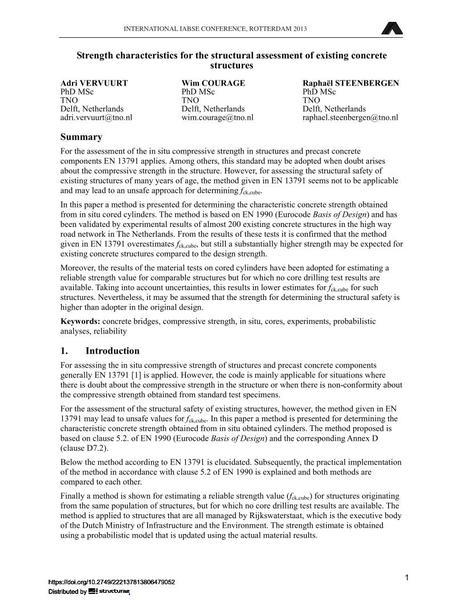Strength characteristics for the structural assessment of existing concrete structures

|
|
|||||||||||
Bibliografische Angaben
| Autor(en): |
Adri Vervuurt
Wim Courage Raphaël Steenbergen |
||||
|---|---|---|---|---|---|
| Medium: | Tagungsbeitrag | ||||
| Sprache(n): | Englisch | ||||
| Tagung: | IABSE Conference: Assessment, Upgrading and Refurbishment of Infrastructures, Rotterdam, The Netherlands, 6-8 May 2013 | ||||
| Veröffentlicht in: | IABSE Conference, Rotterdam, May 2013 | ||||
|
|||||
| Seite(n): | 302-303 | ||||
| Anzahl der Seiten (im PDF): | 8 | ||||
| Jahr: | 2013 | ||||
| DOI: | 10.2749/222137813806479052 | ||||
| Abstrakt: |
For the assessment of the in situ compressive strength in structures and precast concrete components EN 13791 applies. Among others, this standard may be adopted when doubt arises about the compressive strength in the structure. However, for assessing the structural safety of existing structures of many years of age, the method given in EN 13791 seems not to be applicable and may lead to an unsafe approach for determining fck,cube. In this paper a method is presented for determining the characteristic concrete strength obtained from in situ cored cylinders. The method is based on EN 1990 (Eurocode Basis of Design) and has been validated by experimental results of almost 200 existing concrete structures in the high way road network in The Netherlands. From the results of these tests it is confirmed that the method given in EN 13791 overestimates fck,cube, but still a substantially higher strength may be expected for existing concrete structures compared to the design strength. Moreover, the results of the material tests on cored cylinders have been adopted for estimating a reliable strength value for comparable structures but for which no core drilling test results are available. Taking into account uncertainties, this results in lower estimates for fck,cube for such structures. Nevertheless, it may be assumed that the strength for determining the structural safety is higher than adopter in the original design. |
||||
| Stichwörter: |
Zuverlässigkeit Kerne Betonbrücke Druckfestigkeit probabilistische Untersuchungen
|
||||
